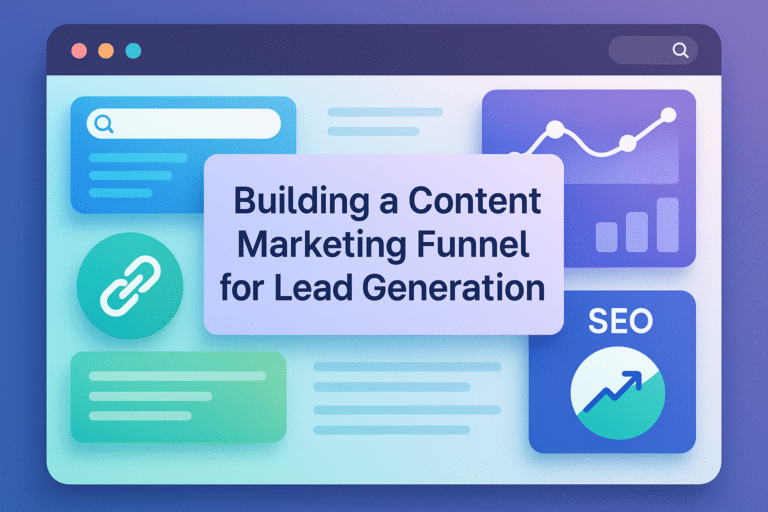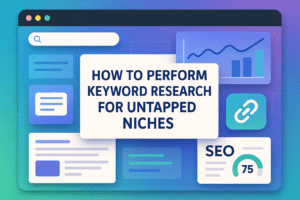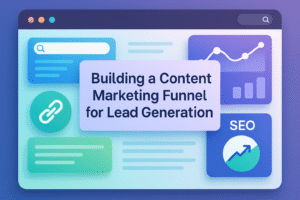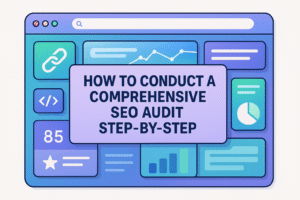Imagine this scenario: you’re set to host an event, anticipating your guests’ arrival, but you haven’t sent any invitations. This oversight parallels having a website without a strategic content marketing funnel to lead prospective customers through their purchasing journey. In today’s digital landscape, outstanding content alone won’t suffice; it’s about strategically leading your audience toward becoming loyal clients.
A content marketing funnel is a vital framework that guides businesses through the customer journey efficiently, starting from the initial interest to fostering enduring relationships. It requires distinguishing between B2B and B2C landscapes, carefully defining stages like awareness, consideration, and decision-making, and developing content that precisely fits each stage. Mastering buyer personas and employing personalized strategies equip marketers with precise tools to effectively target and cultivate their audiences.
In this article, we’ll analyze the fundamentals of building a powerful content marketing funnel aimed at successful lead generation. We’ll break down the critical stages of the buyer’s journey, emphasize the significance of customized content, and highlight the crucial role of data and audience segmentation. Get ready to refine your marketing strategies with insights on using loop models for growth and retention, ensuring your brand remains a consistent presence in your customers’ minds.
Understanding Content Marketing Funnels
A content marketing funnel is a strategic framework designed to guide potential customers through their buying journey, increasing the likelihood of conversion into paying clients. This funnel is divided into three primary stages:
- Top of the Funnel (TOFU): Focused on awareness. Content types often include educational content like blog posts and social media content aimed at attracting a wide audience.
- Middle of the Funnel (MOFU): Revolves around consideration. Here, prospective customers are engaged with more detailed content such as white papers and case studies, offering valuable insights to foster a deeper connection.
- Bottom of the Funnel (BOFU): Centered on decision-making. It provides product demos and direct calls to action, appealing to potential buyers ready for conversion.
Implementing an effective content marketing funnel enables businesses to generate leads, increase revenue, and improve marketing ROI. Each stage requires specific types of content to attract, engage, and convert the target audience effectively.
| Funnel Stage | Content Type | Purpose |
| TOFU | Blog posts, Social media | Awareness and Attraction |
| MOFU | White papers, eBooks | Consideration and Engagement |
| BOFU | Product demos, Case studies | Decision-making and Conversion |
By offering relevant and valuable content, businesses can build trust and credibility with their audience, guiding them seamlessly towards conversion.
B2B vs. B2C Funnels: Key Differences
In the realm of content marketing, B2B and B2C funnels exhibit distinct characteristics primarily due to differences in their target audiences. B2B funnels address multiple stakeholders, such as executives and end-users, unlike B2C funnels, which typically involve fewer individuals, often just one or two. This distinction impacts the complexity and length of the sales cycle, with B2B processes generally taking longer to conclude.
A significant difference lies in the personalization of content. B2B funnels require a tailored approach to meet the diverse needs of various decision-makers. This may include offering educational content like white papers or product demos to better inform and engage potential buyers.
Key Differences:
| Aspect | B2B Funnel | B2C Funnel |
| Target Audience | Multiple stakeholders | Fewer individuals |
| Cycle Length | Longer sales cycles | Shorter sales cycles |
| Content Personalization | Highly personalized content | Generic content may suffice |
| Content Types | White papers, product demos | Social media content, blog posts |
Considering all stakeholders is crucial in B2B funnels, making content marketing strategies more intricate. Understanding these key differences allows content marketers to tailor their efforts for maximum efficacy in both B2B and B2C environments.
Defining the Stages of the Buyer’s Journey
Understanding the buyer’s journey is essential for marketers aiming to optimize their content marketing funnel. This journey maps out how potential customers move from the initial discovery of a brand to making an informed purchasing decision. The journey typically involves stages such as awareness, consideration, and decision-making, each necessitating specific content strategies to guide prospects effectively. Aligning content to address prospects’ needs at each stage plays a critical role in nurturing leads and providing value. By comprehensively segmenting the buyer’s journey, marketers can craft strategies that transition potential customers smoothly from awareness to a final purchase.
Awareness Stage: Attracting Potential Leads
The awareness stage in the content marketing funnel is all about casting a wide net to attract potential leads. Companies aim to introduce their brand and products or services to a broad audience unfamiliar with them. During this stage, channels such as blogging, search engine marketing, and social media are instrumental in reaching potential leads. Utilizing media types—paid, owned, or earned—can effectively segment and attract the right audience. Blog posts, in particular, are a fitting format for this phase, as they answer questions on topics where the brand excels, raising interest and fostering initial engagement. By strategically deploying content, brands strive to extend their reach beyond core audiences and ignite curiosity among prospective customers.
Consideration Stage: Engaging the Audience
The consideration stage marks a pivotal point in the buyer’s journey where the audience is actively evaluating solutions to their problems. Here, demonstrating expertise and the unique value of your offerings is vital. Prospective customers compare options, which presents an opportunity for brands to build trust and establish prominence through curated content. Utilizing webinars as a recurring strategy can amplify the impact of content, engaging potential leads effectively. Content tailored to audience behavior and demographics resonates well in this stage, answering specific questions and concerns. Email courses and downloadable templates also serve as valuable content types, offering in-depth insights and fostering deeper engagement with leads.
Decision Stage: Converting Leads into Customers
In the decision stage, potential customers are poised to make their final purchasing decision. The goal is to convince them that your product or service provides the best solution for their needs. At this juncture, content should underscore the benefits and superiority of your offerings. Offering free trials, demos, or promotional incentives can greatly facilitate a frictionless purchasing experience, enhancing customer satisfaction. It’s crucial to ensure a smooth and pleasant customer journey, helping not only to meet but exceed expectations. This stage is part of a broader content marketing strategy, aiming to close the deal by efficiently supporting the prospective customer’s decision-making process.
Advocacy Stage: Encouraging Referrals and Loyalty
The advocacy stage follows the purchase and focuses on fostering customer loyalty and increasing lifetime value. At this point, the aim is to maintain engagement by creating content that encourages referrals and sharing. Unlike direct referral programs, this stage emphasizes natural promotion due to the inherent value of the content. User-generated content (UGC) can play a significant role, enhancing social proof and reaching a larger audience. Tracking sharing metrics rather than general engagement helps gauge success in this phase. Content here should empower customers to share their positive experiences, potentially turning them into brand advocates, thus driving further engagement and building a loyal community.
Crafting Content for Each Funnel Stage
A content marketing funnel is integral to structuring your content marketing efforts, allowing businesses to systematically attract, engage, and convert their target audience through the buyer’s journey. This funnel is divided into three primary stages: awareness, consideration, and decision. Each stage requires a tailored approach to ensure your message resonates with potential buyers and leads them naturally toward making a purchase. Beginning with the Top of the Funnel (ToFu), your focus is on attracting a broad audience by addressing common problems and introducing your solutions. As prospects move to the Middle of the Funnel (MoFu), the goal shifts to nurturing these leads with content that answers their specific queries and concerns. Finally, at the Bottom of the Funnel (BoFu), persuasive content like product demos and detailed testimonials is essential to close the sale. Aligning your content strategy with these stages helps build trust and provides clarity and value at each step of the customer journey.
Content Types for Awareness
The awareness stage is where potential customers first encounter your brand, often prompted by a problem or need. To capture their attention, content in this stage should be educational and engaging, providing valuable insights related to the audience’s interests and pain points. Blog posts, social media content, infographics, videos, and eBooks are ideal content types for this stage, offering diverse ways to communicate your message. Paid, owned, and earned media can all play crucial roles in amplifying reach and establishing credibility. This is the stage where channels like blogging, search engine optimization, and social media marketing shine, allowing brands to cast a wide net. Companies like HubSpot excel in this area by using targeted blog posts and shareable social media content to address common challenges, thus building trust and generating awareness among prospective customers.
Effective Content for Consideration
As potential buyers progress to the consideration stage, they seek content that not only informs but also supports their evaluation of your offerings. At this stage, your content should be informative, addressing specific questions and concerns the audience might have. Common formats include educational blog posts, webinars, case studies, and white papers, all designed to provide deeper insights into your products or services. Brands like Hilma leverage educational content effectively, using blog articles and interactive tools to illuminate the science behind their products. Measuring the success of this content relies on tracking engagement metrics such as time spent on page and interaction rates. The ultimate aim here is to establish your brand as a trusted advisor, offering the targeted information needed for potential customers to see how your solutions can meet their needs and preferences.
Decision-Focused Content Strategies
At the decision stage, content should be crafted to convert consideration into action. This is when potential customers are ready to make a purchase decision, and your content needs to provide the final push. Effective content formats at this stage include product testimonials, detailed case studies, and how-to guides that illustrate the tangible benefits of your offerings. Companies often create opportunities through strategies like free trials, product demos, and value-laden audits, which can be instrumental in facilitating purchase decisions. The conversion success of decision-stage content is assessed using metrics such as conversion rates and revenue outcomes. Highlighting real-life applications and offering compelling incentives are key tactics to turning prospects into customers at this crucial point in the funnel, ensuring your content marketing efforts translate directly into business growth.
Content to Inspire Advocacy
After a purchase, retaining and transforming customers into brand advocates becomes paramount. Advocacy content is designed to enhance customer loyalty and encourage sharing, creating a cycle of positive reinforcement that extends your marketing reach. This content should be relatable and authentic, spanning everything from informative blog articles to engaging social media posts. Encouraging satisfied customers to leave reviews is a powerful way to generate content that can support further marketing initiatives. Creating personalized content for the post-purchase phase fosters stronger relationships with existing customers, which is significantly more cost-effective than acquiring new ones. Brands often experiment with different content types to understand what resonates most with their audience, refining their strategies to maximize shareability and impact. By focusing on advocacy, businesses can leverage their customer base to drive sustainable growth and amplify their brand presence.
Creating Buyer Personas for Targeted Marketing
Creating buyer personas is essential for targeted marketing as it provides a detailed description of a typical buyer, enabling content creators to tailor messages effectively. Understanding the desires, needs, and pains of your target group is crucial in developing an accurate buyer persona.
A comprehensive buyer persona serves as a foundational brief for content creators looking to connect with their intended audience. It should provide sufficient detail to guide content creators in understanding preferences and behaviors, even though it doesn’t have to be perfect.
To develop precise buyer personas, start by accumulating extensive information about your target group. This involves researching their demographics, interests, and challenges.
Here’s a simplified process for creating buyer personas:
- Gather Data: Conduct surveys, analyze market research, and review your analytics.
- Identify Patterns: Look for common traits and behaviors among your audience.
- Create Detailed Profiles: Develop profiles that include goals, challenges, and how your product or service can help.
By understanding your target audience through well-crafted buyer personas, you can enhance your content strategy and connect more effectively with prospective customers.
Audience Segmentation: Personalizing the Approach
Audience segmentation is a powerful tool that personalizes content delivery by grouping potential customers based on demographics, behavior, and interests. This approach ensures that each piece of content resonates with the target audience, enhancing engagement and conversion rates.
Tools like OptinMonster can be effectively utilized for audience segmentation. By employing these tools, marketers can deliver targeted content to specific groups, increasing the relevance and effectiveness of their campaigns. Segmentation is not just about demographics; behavior-based personalization tailors content according to user activity and interests, further boosting engagement.
Incorporating audience segmentation into your strategy also aids in identifying high-intent visitors. This insight is crucial for creating effective retargeting campaigns, ensuring that prospective customers receive content that addresses their specific needs and interests.
Benefits of Audience Segmentation:
– Targeted Content: Delivering relevant content to defined audience segments.
– Enhanced Engagement: Personalization increases user interaction.
– Effective Retargeting: Focus on high-intent visitors.
– Advanced Targeting: Reach specific personas at different funnel stages.
Employing advanced targeting options in advertising, supported by audience segmentation, enables marketers to reach specific personas with precision, ultimately improving the overall effectiveness of marketing efforts.
Leveraging Full-Funnel Marketing Strategies
Leveraging a full-funnel marketing strategy ensures that relevant content reaches potential customers at each stage of their journey—from awareness to conversion and retention. By integrating both organic and paid content, marketers can guide their target audience effectively, ensuring that the right message impacts the right individuals.
Stages of the Funnel:
- Awareness Stage:
– Focus on educational content.
– Use blog posts, social media content, and White papers. - Consideration Stage:
– Provide more in-depth information.
– Utilize content types like product comparisons. - Decision Stage:
– Highlight product demos and testimonials.
– Focus on conversion-oriented content.
To ensure efficiency, content marketers must continuously optimize their funnel. This includes practices like A/B testing layouts and utilizing Google Analytics to refine strategies, ultimately boosting conversion rates.
| Funnel Stage | Content Type |
| Awareness | Blog posts, White papers |
| Consideration | Product comparisons |
| Decision | Product demos |
Implementing a comprehensive content marketing funnel not only organizes and aligns marketing activities but also improves lead generation and streamlines the sales process.
Measuring Funnel Performance
Measuring the performance of a content marketing funnel is essential to optimize strategies and improve conversion rates. To do this effectively, leveraging analytics tools like Google Analytics, HubSpot, or Semrush is crucial. These tools help track metrics such as traffic, bounce rates, conversion rates, and time on page.
Setting Key Performance Indicators (KPIs) for each stage of the funnel is vital. For example, track blog post views during the awareness stage, webinar signups in the consideration stage, and demo requests at the decision stage. This helps in defining success metrics accurately.
Tools like Hotjar or Crazy Egg offer insights into user behavior, allowing for visualization of interaction points and identifying drop-off areas within the funnel.
Consolidated analytics platforms, such as StoryChief, simplify the reporting process across distribution channels by centralizing key metrics like website traffic and social media engagement.
Additionally, the ImpactHero app provides a straightforward method to detect performance declines at any stage by analyzing traffic sources, user activities, and leads.
Regular analysis and optimization will ensure an effective content marketing funnel, driving valuable results.
The Importance of Loop Models in Content Marketing
Loop models represent a shift in how businesses view consumer interaction and engagement in content marketing. Unlike traditional funnels that solely focus on customer acquisition, loop models emphasize the continuous and dynamic relationship between brands and consumers. By recognizing the cyclical nature of consumer behavior, these models advocate for ongoing engagement, retention, and advocacy, extending beyond the initial purchase. This approach encourages sustainable growth by nurturing long-term relationships and fostering a sense of loyalty among customers. The loop model thus ensures that content marketing strategies support not just conversion but also retention and advocacy, integrating all stages of the customer lifecycle.
Retention: Keeping Customers Engaged
Retention is a crucial element of the post-purchase stage in a loop model, ensuring customers remain engaged and satisfied with their choice. By offering useful learning materials, troubleshooting tips, and personalized follow-ups, brands can enhance customer experiences and foster loyalty. This approach not only leads to repeat business but also encourages word-of-mouth referrals. An effective retention strategy creates upsell opportunities, offering additional products or services to engaged customers. Linking each stage of the funnel through retention emphasizes loyalty and repeat engagements, making it a vital component of any content marketing strategy aimed at increasing long-term customer value.
Nurture: Building Long-Term Relationships
Nurturing relationships through content marketing is essential for guiding potential and existing customers throughout their journey. A dynamic content marketing strategy evolves to maintain engagement and address the needs of leads from awareness to conversion and retention. By focusing on effective content marketing, brands can ensure a natural transition of prospects into long-term customers and brand advocates. This process increases the funnel’s effectiveness by expanding its focus on nurturing relationships over time, encouraging potential customers to become repeat buyers. As engagement deepens, the likelihood of prospects becoming brand advocates grows, bolstering overall content marketing efforts.
Advocacy: Turning Customers into Promoters
Advocacy is the pinnacle of an effective loop model, turning satisfied customers into promoters of the brand. This involves prioritizing authentic and shareable experiences over traditional paid promotions. User-generated content (UGC) plays a pivotal role, encouraging community participation and organic advocacy. By hosting community-driven initiatives such as giveaways, interviews, and events, brands can unify current and potential customers in alignment with their ethos. Post-purchase advocacy extends through personalized interactions like email follow-ups and exceptional customer support, strengthening the consumer-brand connection. Creating content that resonates with the buyer’s journey not only guides customers through decision-making but also fosters long-term advocacy, essential for sustained brand success.
Conclusion: Optimizing Your Funnel for Growth
Optimizing each stage of your content marketing funnel is essential for boosting traffic, nurturing leads, and enhancing conversion rates. This process is vital for both B2B and B2C companies, helping to effectively manage lead generation by exchanging valuable content for potential customers’ contact information. A well-defined funnel is key to understanding the customer journey.
To ensure your funnel is working effectively, it’s important to track KPIs and metrics at every stage using tools like Google Analytics. This will gauge the success of your content marketing strategies and improve lead conversion.
Incorporating a balanced mix of content types is crucial. Your funnel should feature both educational content — crucial for attracting and engaging your target audience — and targeted, decision-stage content like product demos or white papers, aimed at converting prospects into buyers.
Here’s a quick checklist for funnel optimization:
– Awareness Stage: Use blog and social media posts to attract a broad audience.
– Consideration Stage: Offer in-depth guides or webinars to nurture potential buyers.
– Decision Stage: Provide detailed product demos and case studies to finalize conversions.
By honing your content marketing efforts across these stages, you can effectively convert leads into paying customers.
Additional Resources and Tools for Funnel Building
Building an effective content marketing funnel can greatly benefit from utilizing the right tools and resources.
Tools and Resources:
- Usermaven: This tool streamlines the process of constructing a content marketing funnel, enhancing your marketing efforts and maximizing results.
- OptinMonster: Specifically useful for creating bottom-of-the-funnel content, OptinMonster helps convert potential buyers during the decision stage by offering targeted product demos and more.
- Lead Magnet Guides: Resources like How to Create a Lead Magnet and Blog Post Ideas That Your Readers Will Love provide in-depth guidance for crafting engaging content that appeals to your target audience.
- Email Verification Tools: Ensuring your emails reach the intended recipients is crucial at the bottom-of-the-funnel stage. Email verification tools can significantly improve the accuracy of your email campaigns.
- Effective Marketing Software: Using the right marketing software is key for driving measurable results. These tools aid in creating TOFU content, tracking prospective customer interactions, and analyzing data with Google Analytics.
By leveraging these tools and resources, content marketers can effectively optimize their content marketing strategies for awareness, consideration, and decision stages of the funnel.




